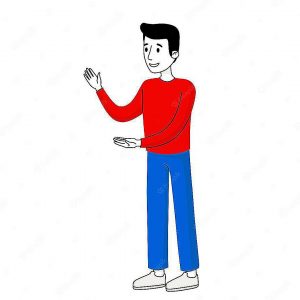Differences Between Flat And Round Characters: Fictional stories have captivating themes and appealing characters that audiences may relate to. Despite the complexity and multidimensionality of many well-known fictional characters, good storytelling frequently calls for the development of a wide range of characters in order to completely support the storyline. It’s crucial to recognize the distinctions between flat and round characters whether you’re a writer or aspire to be one. There are two sorts of characters you may develop: flat characters and round characters.
We define round and flat characters in this article, discuss the distinctions between the two, and provide several instances in which you could utilize these character types in your writing.
Recommended: Differences Between Poem And Poultry
What is a round character?
A complicated character is one that is rounded. These individuals have complex personalities as well as unique motivations, weaknesses, traits, and backgrounds. They have sincere aspirations to act, and their complex, well-defined personalities frequently have opposing traits that advance the plot. The majority of story protagonists are rounded individuals. Throughout the narrative, these characters may evolve.

Additionally, round personalities may astound audiences without jeopardizing their credibility, allowing them to shock audiences without deviating from their character or undermining the audience’s faith in them. Round characters may alter as their environment shifts around them and adapt different facets of their personality to particular conditions.
Also see: Advantages and Disadvantages of Being an Entrepreneur
What is a flat character?
A flat character is one that is uncomplicated. They are comparatively simple and have either one or more personalities. Most one-dimensional characters are flat because they only have one or two personality traits, lack depth, and don’t violate the rules that define them. To make flat characters easier for viewers to grasp, many of them are based on well-known clichés.

Flat characters are rarely able to surprise the audience or alter during a novel. Although they could be straightforward, flat characters don’t always signify poor writing or have uninteresting personalities. Instead, they are frequently colorful or unique yet straightforward characters that are crucial to the plot of a novel. Flat characters provide background for rounded characters and promote the story’s storyline.
Recommended: Differences Between Endnotes And Footnotes
Differences between a round and flat character
Flat and round both describe the intricacy of a fictional figure. Even though each sort of character might have a place in a fictional novel, they all have a certain function. Among the distinctions between round and flat characters are:

1. Fictional genres: Flat and rounded characters may be found in many kinds of fiction. However, some specialized fiction subgenres could have more flat characters than other subgenres. Flatter characters may be found in genres like crime, horror, and science fiction that tend to place a greater emphasis on the story than on character development.
2. Lifelike: Flat characters lack the realistic quality of rounded characters. Characters in the circle have distinctive, well-developed personalities as well as clearly defined histories, goals, and motives. Simple, one-trait characters are referred to as flat characters. The intricacy of round characters frequently matches the complexity of actual individuals.
Also see: Differences Between a Nation And a Country
3. Characteristics: Flat characters have just one or two distinguishing qualities. There are various traits that define round personalities, some of which could even be contradictory. Round figures may so fascinate and astound viewers in this way.
4. Description: Compared to flat characters, round characters are frequently more intricate and challenging to depict. Best flat characters may be described with just a few adjectives or at most, one phrase. Longer descriptions are needed for rounded personalities to adequately convey their subtleties and histories. In the course of a tale, a writer could elaborate on a character’s complexity by continuously exposing new details about them.
5. Role in the narrative: Compared to flat characters, rounded characters often play a more significant or prominent part in the narrative. The protagonists of a tale, in particular, are frequently round figures since readers are more familiar with them. Flat characters tend to be secondary characters, although they can still have an important impact on the plot.

Also see: How to become a good conversationalist
6. Dynamic versus static: Static or dynamic characters are also acceptable. Throughout the plot, dynamic characters go through significant transformations. Characters who are static don’t significantly alter as the tale progresses.
Although flat characters are typically static and rounded characters are dynamic, each character type may be either static or dynamic. Supervillains, for instance, could be static, spherical characters that don’t alter personally by the end of the narrative. A bully in a high school narrative could be a small flat character who decides to quit tormenting others and make friends with them instead, so becoming a dynamic character.
7. Symbolism: Flat figures may operate as symbols in allegories or narratives intended to teach a lesson. Stories that serve as allegories typically have a specific moral or message. Because they lack depth and authenticity, flat characters may be powerful symbols. Similar to round characters, authors don’t often utilize them as symbols since they feel too real for the symbolism to function.
Also see: Differences Between Meditation and Prayer
8. Purpose: Both rounded and flat characters are significant to the plot, and each character has a distinctive effect on it. But round characters are frequently the center of the story, and they are there to draw viewers in and help them grow or evolve as people. The main purpose of flat characters is to advance the plot and provide support for rounded characters.
Flat characters often just have a few characteristics. To describe who they are, these individuals frequently rely on prior knowledge or prejudices. While certain stereotypes about round characters may be true, they develop into more than just the stereotype and have more nuanced personalities.
9. Predictability: Flat characters have a limited number of characteristics, hence their behavior or actions are often predictable. More subtle and sophisticated personalities are round. They can surprise viewers since their conduct and behaviors are less predictable as a result. For instance, a round character could decide in an unexpected way in response to fresh knowledge or a shift in perspective.
Also see: Oldest Buildings In The World (With Pictures)
10. Memorability: Characters that are flat or spherical are frequently remembered differently by audiences. Only their unique traits may help audiences recall flat personalities. For instance, individuals could recall a flat persona as unpleasant, funny, or harsh.
Round characters may be easier for readers to recall because of their traits and behaviors. They could recall these characters as having more complicated features and emotions, and as being more realistic.
11. Perspective: Flat characters frequently just have one point of view or perspective the entire time. Throughout the narrative, round characters could have shifting opinions. Additionally, they frequently express their thoughts and feelings to the audience.
For instance, a round character could go through a struggle that enables them to alter their perception of a certain situation.

Recommended: Key Differences Between Law and Morality Explained
12. Conflict: Personal conflict is experienced by Round characters. This encourages people to alter and drives character growth. Flat characters rarely go through struggle, hence they frequently stay the same throughout the narrative.
Example of a round vs a flat character
You could use these various character kinds in the following circumstances:
i. Plot development: A flat character may frequently progress the storyline of your novel by posing a challenge or hindrance. To behave as a bully and inspire the main character to seek self-awareness and personal development, for instance, you may choose a flat character.
In this instance, the straightforward nature of the flat character might produce a compelling motivation for a round character to start the story’s journey.
ii. Present contrast: To generate contrast, you might choose to utilize characters that are flat or rounded. A sophisticated round character’s decisions and behaviors might seem more original and fascinating when compared to a flat character’s straightforward nature. You may illustrate how a round character differs from other persons like them and how they are similar by presenting a flat character.
Recommended: Differences Between Act And Law
Conclusion
All tale writing must include character development. To make your work credible, regardless of whether your stories are plot- or character-driven, you need a strong understanding of character.

Edeh Samuel Chukwuemeka, ACMC, is a lawyer and a certified mediator/conciliator in Nigeria. He is also a developer with knowledge in various programming languages. Samuel is determined to leverage his skills in technology, SEO, and legal practice to revolutionize the legal profession worldwide by creating web and mobile applications that simplify legal research. Sam is also passionate about educating and providing valuable information to people.